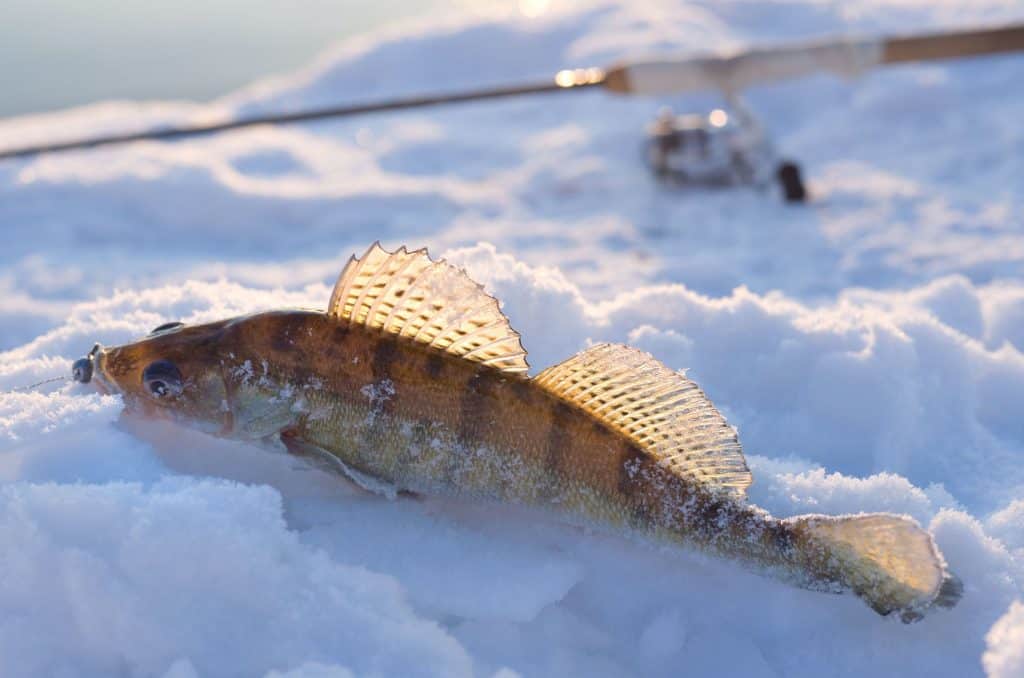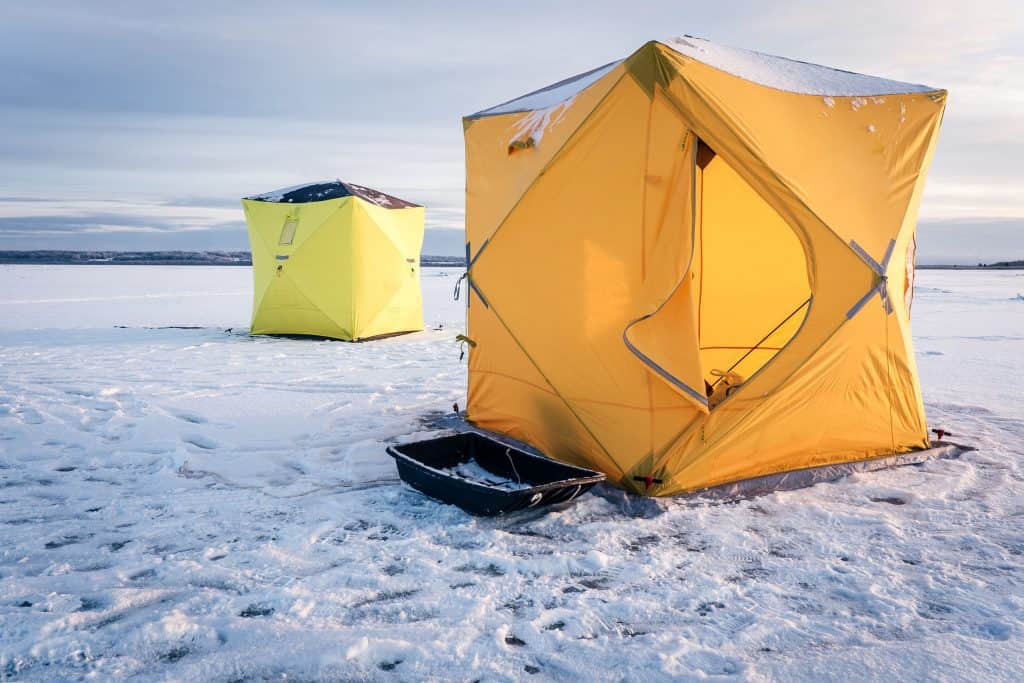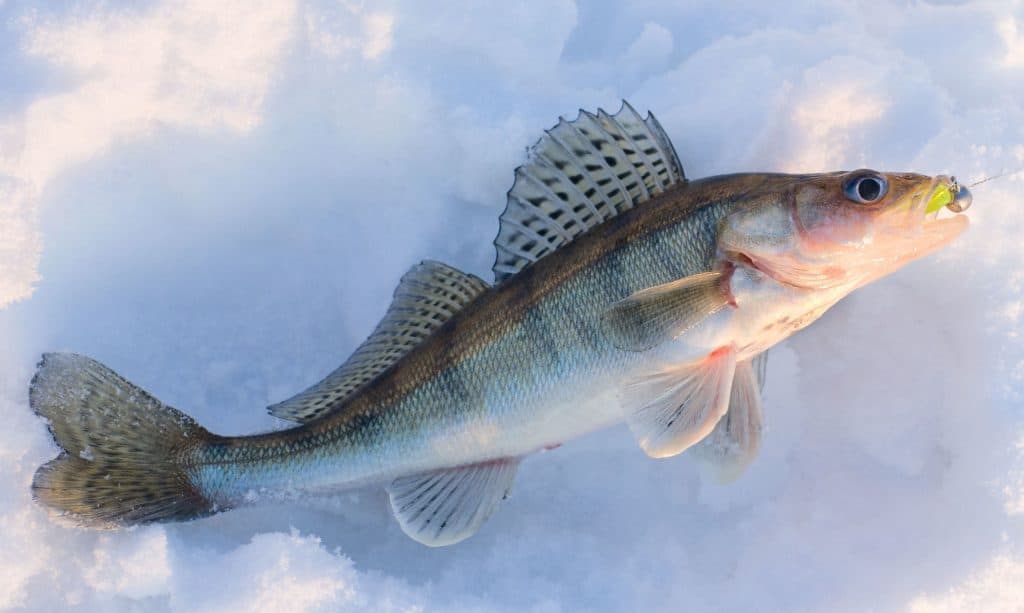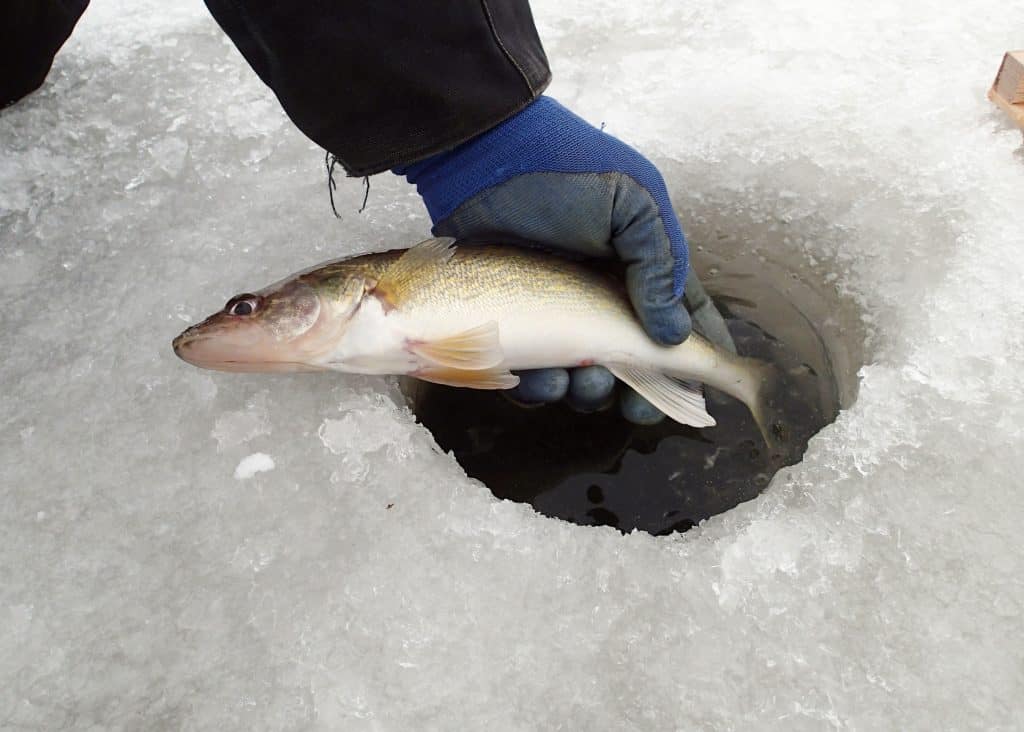A Day's Catch Winneconne, WI | 21 Walleye Ice Fishing Tips to Help You Catch More

Fishing tips for walleye are something in high demand. Walleye are a stubborn fish that needs lots of precise tempting to bite. This fish will give you a challenge and I have provided some helpful tips to give you an edge.
- Get Outside Early
- At Night, Walleye Feed at Shoreline Structures
- Flashy Lures for Finicky Fish
- Practice Your Jigging
- Downsize Your Gear
- Keep Noise to a Minimum
- Try Smaller Bait
- Use Minnows
- Walleyes Hang Near the Bottom
- Send Down a Second Lure
- And others
These are just a few of them. These tips are things that I have learned or come to the conclusion of on my own. These tips have helped me personally when catching fish who will not waste energy unless they really feel the need. It is rough out there in the winter so I hope these tips give you a little warmth while you are out ice fishing.
1.Get Outside Early
Some of the best advice I could give you is finding the correct timing to get the most out of your fishing. Finding that sweet spot in the day will give you the edge you need in ice fishing. During the winter, fish will feed twice a day. Once really early in the morning and once at night. Both times usually are 90-minute intervals.
You can fish outside of these time slots but these are most optimal. The specific hour and minutes of that time period is something you will have to find out from experience. But generally, the times are around sunset and sunrise I personally find that early morning works best for my time schedule.
The only reason why you will find more success is for two reasons. The first being that they are hungry so the fish will be more willing to bite. The second reason is that they tend to be more aggressive when feeding than at any other part of the day. They are pretty lethargic during most parts of the day.
2. At Night, Walleye Feed at Shoreline Structures
During the night, walleyes will get closer to shoreline structures and feed. So sandbars, weeds, or even where the basin transitions and moves up towards more shallow waters. Island areas will become your best friend at night.
See In-fisherman,com’s article answering why it is at night, the fish will feed more intensely than they do during the morning hours. This is their main feeding time and now you know where to find them. Shorelines and islands are optimal but you can find fish at sandbars raises in elevation from the floor of the water.
I definitely suggest looking at maps of the bodies of water that you plan on going to. This will help with deciding what time of day you want to ice fish. There are so many things that can be shared and learned about how to effectively fish and I hope that today you will be taught something because we are just beginning this article.
3. Flashy Lures for Finicky Fish
Walleyes are some of the most stubborn fish I have ever encountered. They frankly are annoying. That being said, they are fun to fish for because it presents a challenge. You have to think smarter than the fish and see how to exploit their weaknesses. Walleye will not bite unless they feel that the bait is interesting enough or worth their time. They are a finicky fish.
That is why I suggest getting lures that are flashy and reflect light off of them. These kinds of lures work great at attracting the fish near to you and then you can hope that they are enticed enough to bite.
I want to share a couple of my favorite ones. The first one I suggest is the Rapala Jigging Rap. It is a really great lure that is simple in design but useful. It works really well on walleye and other kinds of fish. It is not the cheapest fishing lure but it is not overpriced. It has three different kinds of hooks for a variety of fish. The Rapala is well worth the investment.
This next one is probably one of the most unique lures I have ever seen on the market. The Lindy Rattl’N Flyer Spoon has a unique design that makes it falls erratically in the water. This is useful because it helps catch the attention of the fish. Because of its unusually way of moving, it will catch the attention of even the pickiest of fish. To top it all off, it has a rattle which is always good for attracting fish!

4. Practice Your Jigging
To continue the idea of moving the lure, I hope that you have been practicing your jigging skills. Jigging is an art form. I am convinced. I love to watch videos of people using jigging techniques and then catching the fish. It is so cool honestly. Anyways, jigging is super important. Walleye are stubborn. We have established that. That is where jigging comes in handy.
Jigging is the art of shaking the fishing rod ever so slightly to move the lure in the water and make the bait look more appealing. It is a universally recognized technique that pretty much every ice fisher uses.
A lot of people who start out assume that you want to make big swaying motions that are dramatic in the water to catch the fish’s attention. That is actually not what you want to happen. The fish in the water will notice the movement, no problem.
The fish will not fight for something if it looks too hard. During the winter months, they become lethargic and will not expend as much energy as they did during the warmer months. If you moving your lure in big motions and making a huge scene in the water, the fish will not even bother. They will seek for an easier meal.
5. Downsize Your Gear
One of the struggles for those transitioning from normal fishing to ice fishing is having to downsize their gear and their options. In terms of lures, lines, and fishing rods you really do not need a whole lot. Everything is downsized too. I personally think that if you cannot fit your stuff on a sled and/or the inside of your jacket, you have too much stuff.
Lures will not have to be as big. During the winter (say it with me), fish are lethargic and they do not want to do much. If your lures are too big, they will not even bother. It is too much work to even bother with a big meal that will not take minimal effort.
Along those same lines, your fishing rod will be shorter. They usually are about 24 inches which is really tiny in comparison to most rods. They are smaller to create a quicker reaction time and help with feeling what is going down in the water that you can’t see into.
Plus, you will be sitting right about the hole so there is no need to have a really long fishing rod. Ice fishing is more of an intimate experience. That is something that you will find as you ice fish. Seek to downsize and you will catch plenty more fish.
6. Keep Noise to a Minimum
Walleye are not a big fan of noise. They tend to live a life away from human interaction, at least in the winter. They will shy away from lots of noise so keep your tone down. Do not move around a lot. Some fish are attracted to noise above the water but they do not like it.
The science of how walleyes hear is pretty interesting. Their ability to sense vibration comes through their ears and swim bladder. Weird, right? Who knew that fish had ears? Well, they have these things called “otoliths” that are ears. It is pretty cool.
Some sounds scare them off and they react fast because of survival instincts. Those sounds include things like the sound of boats or you walking on top of the ice. Talking could affect this as well but it is less likely.
Sounds that actually work for you are sounds in rattling spoons. The vibrations from those kinds of lures actually bring fish closers. Just be aware of how loud you are and things will go well. Use sound to your advantage and do not let it take away from your fish count!
7. Try Smaller Bait
We touched on this a little during the downsizing part. Of course, your lures should be smaller than the ones you use for fishing on the river during the summer. But even then, you want different sizes and maybe some lures that are even smaller. It is good to have variety. Check your inventory and see if you need some new lures for ice fishing.
Once again, fish get tired during the winter and they just do not want to do anything and will complain if they have to. That is what it feels like anyway. They might not move in for a bite if they feel like the lure is too big. That is a real problem I run into sometimes.
Something I love to teach people is that size matters. Fish come in different sizes and depending on the area you are in, the fish might be smaller or bigger. The bigger the fish, the more options it has for a meal because it can overpower and eat something faster that is smaller.
When fish are smaller, they have to be more selective. This idea is compounded upon when you factor in that it is winter and the fish are more sluggish. Know the fish in your area and then you will know what size of lure to use.

8. Use Minnows
Minnows are a great way to catch a walleye. Walleye want a good meal and minnows are bigger than bait and they are also a fish. This is enticing to walleye. You could just stick the fish on there and call it good but if you get a little crafty, you can get more out of your use of minnows and have a better chance at catching some bigger fish.
The fish alone looks like a tasty meal but what if we were able to send the smell of fish out into the water? You can pinch off the head between dorsal fin and gill plate. Doing this will release amino acids and good flavorful scents into the water.
This will attract the fish to come to get a bite. To have the optimal use out of each minnow, change head ever 5 to 10 minutes. Always keep your minnow heads fresh and you should be good to go.
9. Walleyes Hang Near the Bottom
Walleyes like to chill close to the bottom of the water column during non-feeding hours. If you are going out before sunset or after sunrise, you will most likely find them there. If you have your fish finder, break that out!
This is the most efficient way to find fish in the water. But if you are without a fish finder, search the bottom portion and see what you can get. Just implement the tips I gave you already and you will find some good fish.
Many fish early in the season will exist around vegetation. They receive nutrients from the oxygen in the area. Plus, small organisms that they enjoy eating stay around the vegetation. When checking near the bottom, look for vegetation. This tip has helped me multiple times.
If you see lots of dead weeds that have floated to the top of the ice, do not even bother sending down a line. They will not be next to dead weeds. This generally happens late in the season as the ice stays cold. If you are fishing at the beginning of the season, this will not be as common.
10. Send Down a Second Lure
Fish want to be attracted and sometimes the artificial lures just do not cut it. Attract fish with the artificial lure and send down a second line with a minnow so that they bite on the more enticing meal when they get encouraged by the artificial.
Sometimes despite your best efforts, the fish will not bite. You could do all the jigging that you want and then some but they still do not bite. Sometimes fish will come up close, psych you out, and then leave. That is one of the most infuriating things I have ever experienced. How do you combat this?
Well, the reason why you are probably having this trouble is that you are using an artificial lure with simple bait like wax worms. Which is normally a perfect thing to use. Sometimes it just does not work out. What do you do instead? Send down a minnow. The live bait will attract the fish, but let’s do one better.
12. Sensitive Fishing Rods are the Way to Go
Walleye will bite from the bottom up sometimes. Many kinds of fish have their eyes set closer to the top of the head. You will want to keep the lure above them a bit so they can come up and bite it. Let’s talk about how you can use this to your advantage.
When you ice fish, you will use a tiny fishing rod that is close to you. The lure hanging on the bottom of the line will weight down the rod ever so slightly. When a fish comes up to attack it, you will feel a little slack in the line. You might not notice it at first but you will in time.
With a sensitive fishing rod that is engineered give you the most feeling possible, you can be sure when a fish bites. Your reaction time and the ability to sense what is in the water will increase your chances of catching a fish.
13. Jig Closer to the Water When in Tight Spaces
These next three tips I got from YouTuber, ProFishermanJones. I will link his video at the bottom of these three tips.
Let’s say you use a shanty. Shanties are a great way to keep warm and out of the wind. It also helps me stay focused. There is a problem though, You cannot move around nearly as much. You will want to keep your fishing rod close to the ground so that you have optimal room to move up and down when fishing.
When you fish, you do something called a “hook set.” When the fish grabs the bait, you lift up the fishing rod so as to sink the hook further into the fish’s mouth. you will need a couple of feet to do this.
Some shanties are only five feet tall. That is not a whole lot of room to hook set. If you lower the rod to be a couple of inches above the water, you will gain nearly a foot of extra room to pull up when you hook set. This will help immensely when it comes time to hook a fish and reel ’em in!
14. Keep the Rod Tip Clean of Ice
Going along with the last one, if the rod tip is in the water it will accumulate ice and it will hinder your ability to reel in the fish. That just makes for a bad day. Especially if it is a good catch. Honestly, ice fishing takes a lot more concentration than one would think.
Keep doing what I said to do in the last point but make sure that you are not splashing the water or keeping it in the water. Yes, you want as much room as possible when hook setting but you are not going to get anywhere if you have a frozen rod tip. Keep a wary eye on the proximity of the rod to the water and you should be fine.
15. Do not Get the Line Pinched on the Ice
This next point contradicts what I just said. I said do not put your rod in the water and yet now I am telling you too. When you hook a good walleye, They will swim to either side of the hole but never directly under it. They are smart fish. When this happens, your line will get pinched on the ice. This is one of the easier ways to lose a fish.
You do not want to move your rod to the opposite side of where the fish is going. That does not help you. The best thing to do is to stick the rod right into the water. Do this until the fish calms a little or moves closer to the center.
You will feel less tension when this happens. This contradicts what I said before but you will not have the rod in the water often or long enough for the freezing to happen. It will be quick movements to get the fish to go where you want it.
16. Search Down the Water Column
Some people do not have fish finders, sonar devices, or even cameras for the water. That could be because they do not have the money or because they prefer not to use them. Whatever the case may be, you can still ice fish. It makes me wonder what people back in the day would do?
The Native Americans used to ice fish for years without the kind of technology we have today. They probably knew where the fish would be after generations of fishing and they passed that down to the next generation.
I propose that they might have done this little trick I will explain to you. You only have your eyes and your fishing rod to tell you what is down in the water. Maybe you read up some things online about the prime spots of where to fish on the lake.
Despite all of your learning, you do not actually know where the fish are going to be. What I have done is send down a line until I feel that it reaches the bottom. Then I reel it up a couple of turns and see what happens.
You have to be really patient with this otherwise it will not work. Wait a few minutes and if you cannot find anything, reel it up a few more turns. Every few feet, try and see if anything passes by or if something comes in for a little nibble. You will be able to sense it. It is a really cool experience. It takes patience but it works if you put in the time.
17. Tap Lure on the Rocks at the Bottom
Fish are always trying to find the most enticing food. They only want to attack the best meals. Knowing this, you can use this to your advantage when ice fishing. I have given plenty of tips about lures and different devices that you can use. Modern technology and understanding of fish have given us a lot of help in that area.
If you’re fishing near the bottom, and there is a good chance you will with walleye, find rocks or some solid objects to tap your lure against. It will make some noise and vibrations that will attract the fish. This is one of those timeless tips that will not go wrong. If you are struggling to find fish, try this idea out. Maybe that is all you need to win over some fish.
18. Stir Up the Dust
Similar to tapping rocks, you can use other terrains to make a spectacle. Hit your lure on the bottom of the lake to make some noise. You will kick up a ton of dust this way and it will attract the fish. They are a curious creature. Curiosity really killed the cat this time. This is just another simple idea to try if you get bored or want some extra help.
There is a certain amount of finesse you have to accomplish to do this right. You can’t just keep slamming the jig on the ground and expect the fish to be interested. You have to do it in intervals. I am sure that you will find a rhythm that works for you.
19. Did Your Tip-up Miss the Fish? Send Down a Line
Tip-ups are wonderful inventions used to fish with more than just one line. You send it down at the desired place and when a fish grabs on, the mechanism is triggered and the flag goes up to inform you of your snagged fish. Sometimes (rarely) a fish will grab onto the line and the flag pops up but the hook slides off of the fish or the fish just barely bumps it. What do you do now?
Its a bummer but you can save it. If this happens, grab your fishing rod quickly and hurry over to the hole. Chances are, the fish is still there and still hungry. Sending down a line that control will increase your chance of actually catching the fish. This a quick way to get another chance at a potential fish when the tip-up fails to do so.

20. Space Out Your Tip-ups
Tip-ups are a revolutionary piece of equipment. If you are trying to catch a large amount of fish and want to be efficient with your time, tip-ups are a great way to go. Let’s say you set up 5 tip-ups, you have just increased your chances of catching a fish by that much. One thing that a tip-up can’t do is entice the fish in the same way that you can. The tip-up will not move. The lure will be static and that is not as entertaining nor is it attractive to fish.
The last thing you want to do is set up your tip-ups all around you like in a radius or the circumference of your area. That is pointless plus you might miss a tip-up flag going up. Set them up in your line of sight a few feet from each other. I will explain in my next tip.
21. Line Up Your Tip-ups for More Efficient Use
Tip-ups are meant to help you. If they start to become too much of a distraction or you can’t get to them fast enough, they will lose their purpose. They should work to your advantage. They are meant to catch you fish. What I suggest doing is simple, yet effective.
Set up your shanty or your HQ. You want your tip-ups to be within your line of sight. I suggest drilling holes in a line in front of where you will be sitting. The holes should be somewhere around 3 feet apart. Set up your tip-ups and you are good to go!
This is effective because you do not have to move if it is not needful. You can sit on your 5-gallon bucket, look up every so often and see if any of the flags have moved. Since they are all lined up directly in your line of sight, you will notice right away when a flag goes up. I have found this to be the most effective way to use a tip-up. Hands down.
